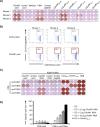CXorf61 is a target for T cell based immunotherapy of triple-negative breast cancer
- PMID: 26327325
- PMCID: PMC4694836
- DOI: 10.18632/oncotarget.4516
CXorf61 is a target for T cell based immunotherapy of triple-negative breast cancer
Abstract
Triple-negative breast cancer (TNBC) is a high medical need disease with limited treatment options. CD8+ T cell-mediated immunotherapy may represent an attractive approach to address TNBC. The objectives of this study were to assess the expression of CXorf61 in TNBCs and healthy tissues and to evaluate its capability to induce T cell responses. We show by transcriptional profiling of a broad comprehensive set of normal human tissue that CXorf61 expression is strictly restricted to testis. 53% of TNBC patients express this antigen in at least 30% of their tumor cells. In CXorf61-negative breast cancer cell lines CXorf61 expression is activated by treatment with the hypomethylating agent 5-aza-2'-deoxycytidine. By vaccination of HLA-A*02-transgenic mice with CXorf61 encoding RNA we obtained high frequencies of CXorf61-specific T cells. Cloning and characterization of T cell receptors (TCRs) from responding T cells resulted in the identification of the two HLA-A*0201-restricted T cell epitopes CXorf6166-74 and CXorf6179-87. Furthermore, by in vitro priming of human CD8+ T cells derived from a healthy donor recognizing CXorf6166-74 we were able to induce a strong antigen-specific immune response and clone a human TCR recognizing this epitope. In summary, our data confirms this antigen as promising target for T cell based therapies.
Keywords: CD8+ T cell epitope; CXorf61; T-cell receptor cloning; TNBC; immunotherapy.
Conflict of interest statement
U.S., Ö.T., C.P., P.S., K.V., C.B., S.H., C.H., are inventors on patents featuring CXorf61. No potential conflicts of interest were disclosed by the other authors.
Figures




Similar articles
-
Development of a CD8 co-receptor independent T-cell receptor specific for tumor-associated antigen MAGE-A4 for next generation T-cell-based immunotherapy.J Immunother Cancer. 2021 Mar;9(3):e002035. doi: 10.1136/jitc-2020-002035. J Immunother Cancer. 2021. PMID: 33771892 Free PMC article.
-
Chimeric peptide containing both B and T cells epitope of tumor-associated antigen L6 enhances anti-tumor effects in HLA-A2 transgenic mice.Cancer Lett. 2016 Jul 28;377(2):126-33. doi: 10.1016/j.canlet.2016.04.031. Epub 2016 Apr 26. Cancer Lett. 2016. PMID: 27130449
-
Characterization of HLA-A2-restricted HPV-16 E7-specific CD8(+) T-cell immune responses induced by DNA vaccines in HLA-A2 transgenic mice.Gene Ther. 2006 Jan;13(1):67-77. doi: 10.1038/sj.gt.3302607. Gene Ther. 2006. PMID: 16107858 Free PMC article.
-
Clinical and immunological effects of mRNA vaccines in malignant diseases.Mol Cancer. 2021 Mar 15;20(1):52. doi: 10.1186/s12943-021-01339-1. Mol Cancer. 2021. PMID: 33722265 Free PMC article. Review.
-
Emerging Immunotherapies against Novel Molecular Targets in Breast Cancer.Int J Mol Sci. 2021 Feb 28;22(5):2433. doi: 10.3390/ijms22052433. Int J Mol Sci. 2021. PMID: 33670942 Free PMC article. Review.
Cited by
-
Immunotherapy in triple negative breast cancer: beyond checkpoint inhibitors.NPJ Breast Cancer. 2022 Nov 9;8(1):121. doi: 10.1038/s41523-022-00486-y. NPJ Breast Cancer. 2022. PMID: 36351947 Free PMC article. Review.
-
Effectors and potential targets selectively upregulated in human KRAS-mutant lung adenocarcinomas.Sci Rep. 2016 Jun 15;6:27891. doi: 10.1038/srep27891. Sci Rep. 2016. PMID: 27301828 Free PMC article.
-
Detection of Kita-Kyushu Lung Cancer Antigen-1, a Cancer/Testis Antigen, in the Stomach Close to a Cancerous Condition.J Cancer. 2022 Oct 31;13(14):3526-3532. doi: 10.7150/jca.67534. eCollection 2022. J Cancer. 2022. PMID: 36484013 Free PMC article.
-
A novel bioinformatic approach reveals cooperation between Cancer/Testis genes in basal-like breast tumors.Oncogene. 2024 May;43(18):1369-1385. doi: 10.1038/s41388-024-03002-7. Epub 2024 Mar 11. Oncogene. 2024. PMID: 38467851 Free PMC article.
-
CAR T-Cell Cancer Therapy Targeting Surface Cancer/Testis Antigens.Front Immunol. 2020 Sep 2;11:1568. doi: 10.3389/fimmu.2020.01568. eCollection 2020. Front Immunol. 2020. PMID: 32983080 Free PMC article. Review. No abstract available.
References
-
- Perou CM, Sorlie T, Eisen MB, van de Rijn M, Jeffrey SS, Rees CA, Pollack JR, Ross DT, Johnsen H, Akslen LA, Fluge O, Pergamenschikov A, Williams C, et al. Molecular portraits of human breast tumours. Nature. 2000;406:747–752. - PubMed
-
- Hudis CA, Gianni L. Triple-negative breast cancer: an unmet medical need. Oncologist. 2011;16:1–11. - PubMed
-
- Scanlan MJ, Gure AO, Jungbluth AA, Old LJ, Chen YT. Cancer/testis antigens: an expanding family of targets for cancer immunotherapy. Immunol Rev. 2002;188:22–32. - PubMed
Publication types
MeSH terms
Substances
LinkOut - more resources
Full Text Sources
Other Literature Sources
Molecular Biology Databases
Research Materials

